Toyota Automatic Transmission Fluid
Toyota markets their own automatic transmission fluids under the Toyota brand name[1]. Toyota does not license their automatic transmission fluid specifications to companies who wish to manufacture the fluid and sell it under their own brand names. Toyota dealerships and online retailers sell the Toyota branded fluids today. If the official Toyota logo is not found on the container, the fluid may not be Toyota approved and the fluid cannot be guaranteed to meet Toyota specifications
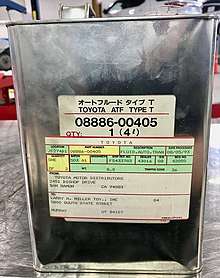
Toyota Automatic Transmission Fluids (ATF)
The original Toyota Type-T transmission fluid was not introduced until 1988. Over the years, the original specification was supplanted by Type T-II, Type T-IV, and the WS fluid, which is the latest fluid. Toyota has upgraded the ATF specifications over the years; the newer fluids are not always backward compatible with previous fluids. Newer 6, 8, and 10-speed transmissions as well as Hybrid-Electric (HEV), Plug-In Hybrid (PHEV), CVTs, and Electric Vehicle (EV) transmission technologies require specialized fluids to operate properly. There remains a market for older fluids that claim to meet the earlier fluid specifications. See the details below for backward compatibility of each fluid.
Before Toyota ATF - 1959 - 1988
1959 - GM Type "A" Suffix "A" Fluid
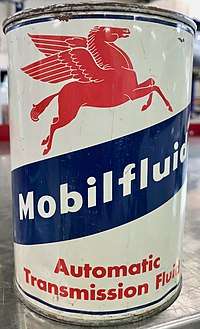
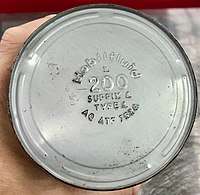
In 1957, General Motors (GM) released a new Type "A" Suffix "A" fluid specification[2]. This fluid was better suited for the higher fluid temperatures caused by the unique torque converters and higher power engines of the day. The fluid specification was revised again in 1958, 1959, and 1960.
In 1959, Toyota adopted the GM Type "A" Suffix "A" fluid specification. Toyota recommended the following brands of Type "A" Suffix "A" fluids:
- British Petroleum (BP) ATF Type "A" Suffix "A" fluid
- Caltex Texamatic Type "A" Suffix "A" fluid
- Esso Standard ATF Type "A" Suffix "A" fluid
- Mobil Mobilfluid 200 Type "A" Suffix "A" fluid (see photos)
- Shell Donax T-6 Type "A" Suffix "A" fluid
This fluid was first used in the 1962 Toyota Corona (RT40, RS43L, MS43L, RT43L) used the following transmissions:
- 1959 A10 2-Speed Toyoglide Semi-Automatic transmission (Toyota's first semi-automatic transmission)
- 1962 A20 2-Speed Toyoglide Automatic transmission (Toyota's first fully automatic transmission)
1966 - Ford Type-F Fluid
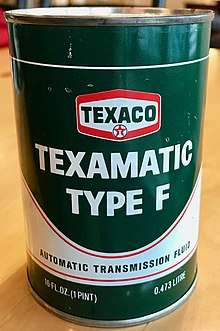
In 1966, Toyota adopted the Ford Type-F (M2C33-F) fluid specification[3]. This upgraded fluid had improved low-temperature viscosity to provide for adequate shifting times in low temperatures. The fluid also had better oxidation resistance characteristics which resulted in longer fluid life.
Toyota recommended the following brands of Ford Type-F fluids:
- Castrol TQ Type-F
- British Petroleum (BP) ATF Type-F
- Caltex Texamatic Fluid Type-F (see photo)
- Esso Standard Glides
- Mobil Mobilfluid 210 ATF
- Shell Donax T-7
- White Rose Type 7 ATF
This fluid was first used in the 1967 Toyota Crown and Corona Mark II with the following transmission:
- 1967 A30 3-Speed Toyoglide transmission.
1969 - GM Dexron (B) Fluid
.jpg)
In 1968, Toyota adopted the GM Dexron (B) fluid specification[4]. This upgraded fluid had improved low-temperature viscosity to provide for adequate shifting times in low temperatures. The fluid also had better oxidation resistance characteristics which resulted in longer fluid life. Toyota became a licensed reseller of the GM Dexron (B) fluid; it was marketed under the Toyota brand name.
This fluid is backward compatible with all Type "A" Suffix "A", but not Ford's Type-F fluid.
This fluid was first used in the following transmissions:
- 1970 Toyota A32 3-Speed Electronically Controlled Automatic Transmission (EAT) RWD.[5]
- 1972 Toyota A40 (Developed with Borg-Warner Co.) (AW) 3-Speed RWD
1973 - Dexron II(C) Fluid
In 1973, Toyota adopted the GM (MS-7176) with GM Dexron-II(C). This upgraded fluid had new oxidation and rust inhibitors to replace the previous sperm whale oil additive. The fluid also had better oxidation resistance characteristics which resulted in longer fluid life. Toyota became a licensed reseller of the GM Dexron-II(C) fluid; it was marketed under the Toyota brand name. This fluid superseded the previous fluid.
1975 - Dexron II(D) Fluid
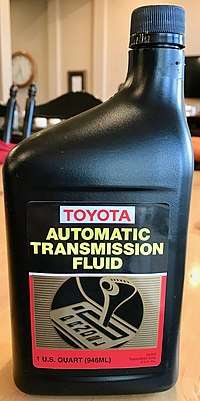
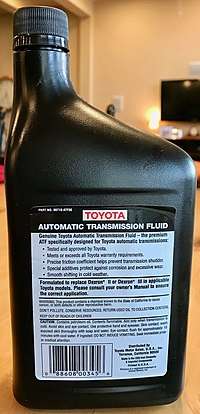
In 1975, Toyota adopted the GM (GM6032M) with GM Dexron-II(D) fluid specification. The fluid had better oxidation resistance characteristics which resulted in longer fluid life. Toyota became a licensed reseller of the GM Dexron-II(D) fluid; it was marketed under the Toyota brand name. This fluid superseded the previous fluid.
This fluid was first used in the following transmissions:
- 1977 Toyota A40D 4-speed AT with Overdrive RWD (A World's First)[6]
- 1979 Toyota A55 3-Speed FWD
- 1980 Toyota A43DL 4-Speed RWD w/TCC
- 1981 Toyota A43DE 4-Speed w/TCC World's first microcomputer-controlled RWD AT[7]
- 1982 Toyota A140L/A140E World's first FWD 4-Speed w/TCC ATX - Camry[8]
- 1984 Toyota A340L 4-speed AT for trucks
- 1984 Toyota A340H Electronic controlled AWD RWD 4-Speed w/TCC
- 1989 Toyota A341E Electronic controlled RWD 4-Speed w/TCC
NOTICE: The Dexron-II(D) fluid was superseded by the GM Dexron-III(H) fluid specification in 2002. (See Toyota Technical Service Bulletin TC001-02)
Toyota ATF 1988 - Today
1988 - Type T Fluid

In 1988, Toyota released their first automatic transmission fluid specification; Toyota Type T Fluid (See Toyota TSB Volume 9-10 04-10-1988.)
This fluid was first used in the following transaxles:
- 1988 A241H AWD transaxle in the Corolla
- 1988 Toyota A540H Electronic controlled AWD[9] 4-Speed transaxle w/TCC
- 1992 Toyota A341H Electronic controlled AWD 4-Speed w/TCC.
This fluid is not backward compatible with any previous Toyota recommended fluid.
1993 - Type T-II Fluid
1993 Toyota made several changes to their transmission fluid recommendations:
- Toyota released the Type T-II ATF High-Performance Fluid Specification for A340Ei in 1993 Turbo Supra and others.
- Replaces Dexron II(E) with Dexron III(G).
This fluid is not backward compatible with the previous Type T fluid.
This fluid was first used in the following transmissions:
- 1993 Toyota A340Ei Electronic controlled RWD 4-Speed w/TCC – Turbo Supra
- 1996 Toyota A350E Electronic controlled RWD 5-Speed w/TCC – Lexus GS300
1995 - Type T-III Fluid
In 1994-1995, some early OBD-II phase-in vehicles experienced a P0300 DTC (Random Misfire). Engineers determined that road forces being transferred through the Torque Converter Clutch (TCC) was affecting the normal rotational fluctuations of the crankshaft and tricked the ECM into thinking there was a cylinder misfire.
The solution was to create a new kind of TCC that would normally slip around 35 rpm. Toyota called theirs a Slip Controlled Lock-Up Clutch (SCLC), other manufacturers had their own names. Some SCLC systems had a shudder or vibration during normal operation. Engineers tried several computer calibration changes, but a revised fluid was also needed to address the issue.
- Toyota released the Type T-III ATF in 1995[10][11]
- Ford released the new Mercon V fluid specification in 1996
- GM released the Dexron-III (G) fluid specification in 1998
- Chrysler released the MS-9602 Change C fluid specification (MS-9602) in 1998.[12]
1998 - Type T-IV Fluid
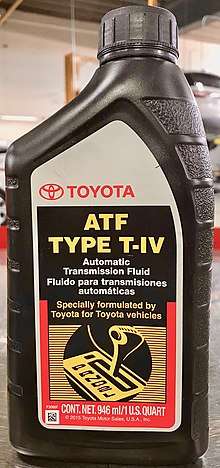
In 1998, Toyota releases the Genuine ATF Type T-IV Fluid Specification (JWS3309). This fluid was the Next Generation High-Performance ATF for Slip-Controlled Automatic Transmissions[13]. This fluid replaces Type T-III, Type T-II and Type T fluids in all vehicles. All vehicles produced after 1993 with Automatic Transmissions specified to use ATF Type T, T–II and T–IV. (See Bulletin TC003–99)[14]. Do not confuse this fluid with Chrysler's Mopar ATF+4, they are not interchangeable.
NOTICE:
- Type T-IV fluid is backward compatible with the previous Type T fluid.
- Type T-IV can replace Type T-II fluids; however, they should not be mixed.
This fluid was first used in the following transmissions:
- 1998-2003 Toyota P111 Hybrid Transaxle[15]
2002 - WS Fluid
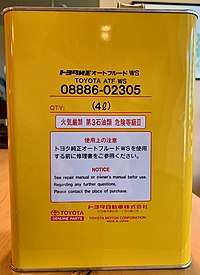
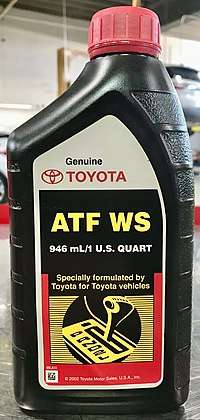
In 2002, Toyota releases the Genuine ATF WS (World Standard) Fluid Specification (JWS3324 or NWS9638).[16][17] This fluid is not backward compatible with previous Toyota fluids or Dexron fluids. Almost all 2004 and above Toyota vehicles with automatic transmissions use the WS fluid specification. this fluid absorbs moisture and should never be reused. Always use fluid from an unopened container. See Toyota bulletin T-SB-003-11
Toyota asserts that under normal usage, the fluid has a 160,000 km (100,000 miles) maintenance interval for inspection only; ATF-WS does not require any flushing or changing during the life of the vehicle; however, an inspection of the maintenance schedule of many Toyota vehicles reveals that there is a 100,000 km (60,000 miles) replacement interval if the vehicle is used on short trips, city driving, hauling heavy loads, trailer towing, or using a car-top hauler. Check your own maintenance schedule for your vehicle's requirements.
This fluid is not backward compatible with any previous Toyota recommended fluid.
This fluid was first used in the following transmissions:
2011 - CVT Fluid TC
In 2011, Toyota released the CVT fluid TC fluid specification for Continuously Variable Transmissions (CVT).
This fluid was first used in the following transmission:
- 2012-2013 K41B (Scion IQ)
2013 - CVT Fluid FE
In 2013, Toyota released the CVT fluid FE fluid specification for Continuously Variable Transmissions (CVT).
This fluid was first used in the following transmissions:
- 2013 K313 (Corolla)
- 2014 K41B (Scion IQ)
- 2017 K114 (C-HR)
- 2017 K312 (Yaris Thailand)
- 2020 K120 (Corolla)
Toyota "Lifetime" ATF
In 1967, Ford produced the Type-F fluid specification. The Type-F specification was intended to produce a “lifetime” fluid which would never need to be changed. This was the first of many Ford “lifetime” fluids. The 1974 Ford Car Shop Manual reads "The automatic transmission is filled at the factory with "lifetime" fluid. If it is necessary to add or replace fluid, use only fluids which meet Ford Specification M2C33F. Many other transmission manufacturers have followed with their own "Lifetime" automatic transmission fluids". Toyota's first "Lifetime" ATF was the World Standard (WS) specification in 2002.
How ATF Can Last a "Lifetime"
To understand how a fluid can last a "lifetime", a study of the 1939 Chrysler Fluid Drive Fluid is helpful[21]. The November 1954 edition of Lubrication Magazine (Published by The Texas Company, later known as Texaco) featured a story called "Evolution of the Chrysler PowerFlite Automatic Transmission". This article described the fluid used in the 1939 Chrysler Fluid Drive and its subsequent revisions and enhancements through 1954.
A section of the feature described the lubrication of the Fluid Drive's fluid coupling, it reads "The fluid drive fluid coupling is partially filled with Mopar Fluid Drive Fluid, a special highly refined straight mineral oil with a viscosity of about 185 SUS at 100° F., excellent inherent oxidation stability, high viscosity index (100), excellent ability to rapidly reject air, very low natural pour point (-25° F.) , ability to adequately lubricate the pilot ball bearing and seal surface, and neutrality towards the seal bellows.
The fluid operates under almost ideal conditions in what is essentially a hermetically sealed case, the small amount of atmospheric oxygen initially present is removed by a harmless reaction with the fluid so as to leave a residual inert (nitrogen) atmosphere. As a consequence, it has not been necessary to drain and replace the fluid, and the level-check recommendation has been successively extended from the original 2,500 miles to 15,500 miles and finally to "never" - or the life of the car.
Since drains and level checks were not only unnecessary but frequently harmful ( through the introduction of more air, and seal-destroying dirt) Chrysler eventually left off the tempting level inspection plugs. This mechanism is, therefore, one of the very few that are actually lubricated for the life of the car. There are now myriad examples of couplings that have operated well over 100,000 miles without any attention whatsoever and were still in perfect condition when the car was retired." The lesson learned by Chrysler with its fluid drives is applicable to modern automatic transmissions as well.
Sealed Transmissions
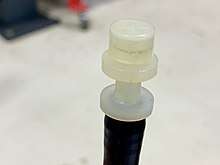
Any automatic transmission fluid will last longer if the transmission case could be hermetically sealed, but transmissions typically have two potential entry points for air:
- The Dipstick Tube. Any transmission with a dipstick tube has the potential to let additional oxygen into the transmission through a dipstick that is not fully seated in the tube, or dipstick tube plug that is not fully seated. Even the process of checking the fluid level with a dipstick can allow additional oxygen and dirt into the transmission. Many modern transmissions do not have a dipstick, they have sealed transmission fluid level check plugs instead. By removing the traditional dipstick, the transmission manufacturer has also removed a potential entry point for oxygen; this reduces the potential for fluid oxidation. A sealed transmission will typically have longer transmission fluid life than a non-sealed transmission.
- The Transmission Vent. Transmissions need vents to compensate for internal air pressure changes that occur with fluctuating fluid temperatures and fluctuating fluid levels during transmission operation. Without those vents, pressure could build resulting in seal and gasket leaks. Before the use of better quality base oil in ATF in the late 1990s, some older transmission breather vents contained a Transmission Air Breathing Suppressor (TABS) valve to prevent oxygen and water ingestion into their transmissions.[22]. Oxygen reacts with high-temperature transmission fluid and can cause oxidation, rust, and corrosion. Automatic transmission fluids using lower quality base oil oxidized more easily than fluids using higher quality base oils.[23] Toyota, and other transmission manufacturers now use smaller, remote mounted, breather vents specially designed to keep out water, but allow a small amount of air movement through the breather as necessary.[24]
Sealed ATF Containers
Any automatic transmission fluid will last longer if it comes from an unopened container
- Use Sealed Containers. Containers storing automatic transmission fluid (ATF) should always be sealed; if exposed to the atmosphere, ATF may absorb moisture and potentially cause shift concerns.
- Use New Fluid Only. When performing repairs on ATF equipped transmissions, it is important to use only new, clean ATF when refilling the transmission. Never reuse ATF.
Example Maintenance Schedules
Toyota Lifetime automatic transmission fluids made from higher quality base oil and an additive package are more chemically stable, less reactive, and do not experience oxidation as easily as lower quality fluids made from lower quality base oil and an additive package. Therefore, higher quality transmission fluids can last a long time in normal driving conditions (Typically 120,000 miles (193,121 km) or more).
The definition of 'Lifetime Fluid" differs from transmission manufacturer to transmission manufacturer. Always consult the vehicle maintenance guide for the proper service interval for the fluid in your transmission and your driving conditions.
2018 Camry Example
According to the Scheduled Maintenance Guide of a 2018 Toyota Camry with WS "Lifetime Fluid" and an 8-speed automatic transmission, the automatic transmission fluid never needs to be changed under "Normal" driving conditions; however, there are Additional Maintenance Items for Special Operating Conditions:[25]
Normal Driving
- Carry passengers and cargo within recommended limits on the Tire and Loading Information label
- Driven on reasonable road surfaces within legal driving limits.
Under "Normal" driving conditions, the automatic transmission fluid never needs to be changed.
Special Operating Conditions
- Driving while towing
- Using a car-top carrier
- Heavy vehicle loading
- Extensive idling and/or low speed driving for a long distance such as police, taxi or door-to-door delivery use.
Under "Special Operating Conditions", replace automatic transmission fluid and filter every 60,000 mi (96,560 km) or 72 Months.
2018 Tacoma Example
According to the Scheduled Maintenance Guide of a 2018 Toyota Tacoma with WS "Lifetime Fluid" and an 6-speed automatic transmission, the automatic transmission fluid never needs to be changed under "Normal" driving conditions; however, there are Additional Maintenance Items for Special Operating Conditions:[26]
Normal Driving
- Carry passengers and cargo within recommended limits on the Tire and Loading Information label
- Driven on reasonable road surfaces within legal driving limits.
Under "Normal" driving conditions, the automatic transmission fluid never needs to be changed.
Special Operating Conditions
- Driving while towing
- Using a car-top carrier
- Heavy vehicle loading
- Extensive idling and/or low speed driving for a long distance such as police, taxi or door-to-door delivery use.
Under "Special Operating Conditions", replace automatic transmission fluid and filter every 60,000 mi (96,560 km) or 72 Months.
Aftermarket Automatic Transmission Fluids
For over 70 years, the oil aftermarket has produced both licensed, and non-licensed, formulations of automatic transmission fluids (ATF)[27]. Today, aftermarket fluids asserted by their manufacturers to be compatible for use in various brands of automatic transmissions continue to be sold under names such as Multi-Purpose and Multi-Vehicle fluids. Non-licensed fluid is typically less expensive, these fluids are not regulated or endorsed by the vehicle manufacturer for use in their transmissions. Make sure the fluid to be installed into a transmission matches the recommended fluid in the specifications section of the vehicle's owner's manual.
Mislabeled or Misleading Labeling on ATF Containers
ATF which has been mislabeled, has misleading labeling, or is fraudulently bottled as another product is an ongoing problem. Some of these fluids have led to multiple transmission failures.[28] The three organizations shown below are trying to stop this problem in the United States.
- United States Laws: The U.S. Department of Commerce, National Institute of Standards and Technology (NIST), Handbook 130 2019 Edition, contains Uniform Laws and Regulations in the Areas of Legal Metrology and Fuel Quality. Section IV.G.3.14 defines laws regulating the Labeling and Identification of Transmission Fluid.[29] Paragraph IV.G.3.14.1.1. Container Labeling. reads The label on a container of transmission fluid shall not contain any information that is false or misleading.
- California Laws: The State of California has developed additional Laws in an attempt to prevent mislabeled and misleading labeling. Statutes: California Business and Professions Code, Division 5, Chapters 6, 14, 14.5, and 15.[30] Regulations: California Code of Regulation, Title 4, Division 9, Chapters 6 and 7.[31]
- American Petroleum Institute (API) Monitoring: The American Petroleum Institute (API) maintains a list of invalid labeling of petroleum products. This real-time list includes motor oils and ATF.[32]
See also
References
- https://mafiadoc.com/automatic-transmission-fluid-requirements-t-tc001-02-toyota-parts_5a1671c01723ddf8dce3c2e3.html 2002 Toyota Technical Service Bulletin T-TC001-02 Automatic Transmission Fluid Requirements
- https://www.sae.org/publications/technical-papers/content/600069/ DEVELOPING TRANSAXLE FLUID
- "Type F Automatic Transmission Fluid and Power Steering Fluid".
- https://www.sae.org/publications/technical-papers/content/680038/ Dexron Automatic Transmission Fluid
- http://www.retrojdm.com/ScanView.asp?ScanID=56 TOYOTA CORONA BROCHURE 1971.11 - EAT AUTO TRANSMISSION
- https://www.sae.org/publications/technical-papers/content/780097/ Toyota Four-Speed Automatic Transmission with Overdrive
- https://www.sae.org/publications/technical-papers/content/820740/ Toyota Computer Controlled Four-Speed Automatic Transmission
- https://www.sae.org/publications/technical-papers/content/840049/ Toyota New Four-Speed Automatic Transmission for Front Wheel Drive Vehicles
- https://www.sae.org/publications/technical-papers/content/890526/ Toyota EC-HYMATIC – A New Full Time 4WD System for Automatic Transmission
- https://www.sae.org/publications/technical-papers/content/952348/ Development of Automatic Transmission Fluid for Slip-Controlled Lock-Up Clutch Systems
- https://www.sae.org/search/?qt=972927 Next Generation High Performance ATF for Slip-Controlled Automatic Transmission
- "Chrysler transmission fluids: 7176, ATF+3, ATF+4". www.allpar.com. Retrieved 2019-02-01.
- https://www.sae.org/search/?qt=972927 Next Generation High-Performance ATF for Slip-Controlled Automatic Transmission
- https://www.scionlife.com/misc/tc003t99.pdf Toyota Technical Service Bulletin TC003–99, Automatic Transmission fluids
- https://www.youtube.com/watch?v=roLqayjWpb0 1st Generation Prius Transaxle - P111
- https://www.sae.org/publications/technical-papers/content/2003-01-3258/ Development of New Automatic Transmission Fluid for Fuel Economy
- https://www.toyoheadquarters.com/threads/toyota-ws-world-standard-automatic-transmission-fluid.1432 Toyota Technical Service Bulletin T-SB-0006-11 Revision 1, Toyota (WS) World Standard Automatic Transmission Fluid/
- https://www.youtube.com/watch?v=ia6jJO3cuOY 2nd Generation Prius Transaxle - P112
- https://www.youtube.com/watch?v=QhIcVM9-F3I World's First 8-Speed Automatic Transmission - AA80E
- https://www.sae.org/publications/technical-papers/content/2017-01-1099/ Development of Innovative Toyota 10-Speed Longitudinal Automatic Transmission
- "Evolution of the Chrysler PowerFlite Automatic Transmission". Lubrication. Vol. 40 no. 11. New York, NY: The Texas Company. November 1954 [1954]. pp. 129–135.
- https://patents.google.com/patent/US5129422A/en?oq=US5129422 Transmission breather control valve
- https://www.sae.org/publications/technical-papers/content/740055/ Transmission Air Breathing Suppressor (TABS) Valve - A Device for Improving Automatic Transmission Fluid Life
- https://patents.google.com/patent/US20110173935A1/en?oq=US20110173935A1 Transmission breather assembly
- https://www.toyota.com/owners/resources/owners-manuals/camry/2018 Manuals & Warranties
- https://www.toyota.com/owners/resources/owners-manuals/tacoma/2018 Manuals & Warranties
- https://www.youtube.com/watch?v=8oWFTOY-3tY%7C 80 Years of GM Automatic Transmission Fluid - ATF History Part 2
- https://www.bar.ca.gov/pdf/Product_Labeling_Regulations_4.18.19.pdf
- https://nvlpubs.nist.gov/nistpubs/hb/2019/NIST.HB.130-2019.pdf
- https://www.cdfa.ca.gov/dms/programs/Publications/BPC/2019/14.5-BPC_2019_Chapter_14.5_ServiceStations_13650-13660.pdf
- https://govt.westlaw.com/calregs/Browse/Home/California/CaliforniaCodeofRegulations?guid=I519487C0D45911DEA95CA4428EC25FA0&originationContext=documenttoc&transitionType=Default&contextData=(sc.Default)
- https://www.api.org/products-and-services/api-monogram-and-apiqr/monogram-apiqr-unlicensed-facilities-list